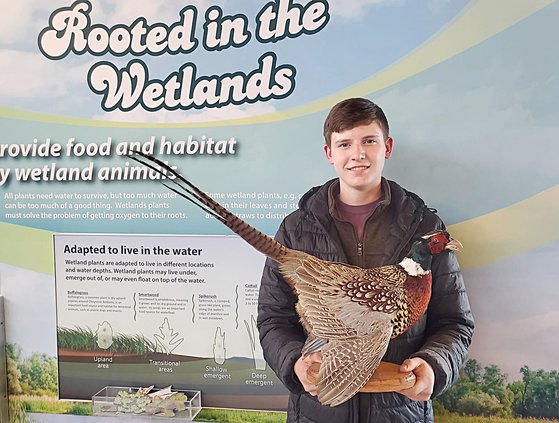Those who have worked on a taxidermy project know that it is an excellent way to preserve animals for study or display. They also know that it can be a tedious and sometimes messy prospect.
In consideration of projects for the Kansas Wetlands Education Center’s WILD program at Cheyenne Bottoms, Mandy Kern, Fort Hays State University program specialist, thought a taxidermy class would be a way to interest older students in a KWEC project for the day.
“A lot of our programs are designed to engage younger students and this one would be a way to get some older students involved,” she said. “With the students out for Christmas break, it seemed a good time to do it.”
Kern enlisted the assistance of Ellinwood science teacher Andrew Wittenberg to conduct the Thursday class in creating a pheasant mount. While Wittenberg has experience in the science of taxidermy, it was his first time teaching a class at the KWEC.
“Back in the day, at school in Chase, we did a little bit this, but for an actual class at KWEC, this is my first time ever,” Wittenberg said.
The class was open to students aged 12-18. Students aged 12-14 were required to attend with an adult.
While registration required participants to bring their own pheasant, the KWEC had a few of their own specimens on hand to use. The students (and in a couple cases, their dads) needed every bit of time allotted in the time period from 8 a.m. to 5 p.m. to complete a finished mount.
The messiest aspect of the process, preparing the bird for mounting, was accomplished Thursday morning. Wittenberg walked his class through the process of separating the flesh and body bones, leaving the legs, tail, shoulders and neck intact.
Wooden frames constructed by Ellinwood industrial arts teacher (and Mandy’s husband) Joseph Kearn allowed the participants to suspend their subjects while performing the cleaning process.
Once this was done, the afternoon was spent in adding support wires and sewing in the body mount, enabling the bird to be posed in a lifelike posture.
Wittenberg offered hands-on instruction, traveling around the room to help with a stubborn wire attachment and body placement.
A first-time experience
For nearly all participants, Thursday’s class was a first-time experience.
• Tristan Thompson, a Larned High School sophomore, noted he had experimented with some taxidermy projects on his own, but decided to attend the class to learn more.
“I think I’d better keep it in my room, I don’t think that my mom would appreciate it in the living room,” he said. Thompson is an avid hunter, and the subject he was working on was harvested near Belpre. “Exactly where, I’m not going to say,” he said. “I can’t give away all my good hunting spots.”
• Trey Smith and his dad Eric, Great Bend, were a father-son novice team. “We spent the morning digging the meat out,” Eric said. “We got a crash course and are moving ahead.”
• Nolan Fisher, Holyrood, thought it would be a good father-daughter project and so he talked his daughter Sunny into it.
“We are working on one the KWEC had that was pen-raised,” Fisher noted. “The one I had shot was in the mud and its feathers were all a mess.”
“Dad had a good idea,” Sunny said. “It’s been fun.”
After the taxidermy outing, the KWEC was busy with a drop-in STEM session Friday with more bird experiments and winding up with a station on Wetlands stop motion tech. Check out their Facbook page for more info on future events.





